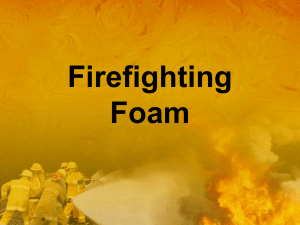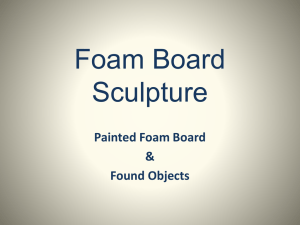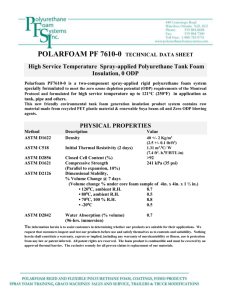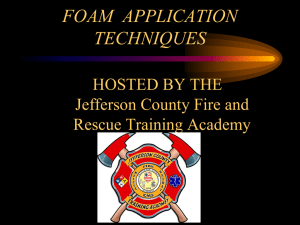(Firefighting Foam).
advertisement
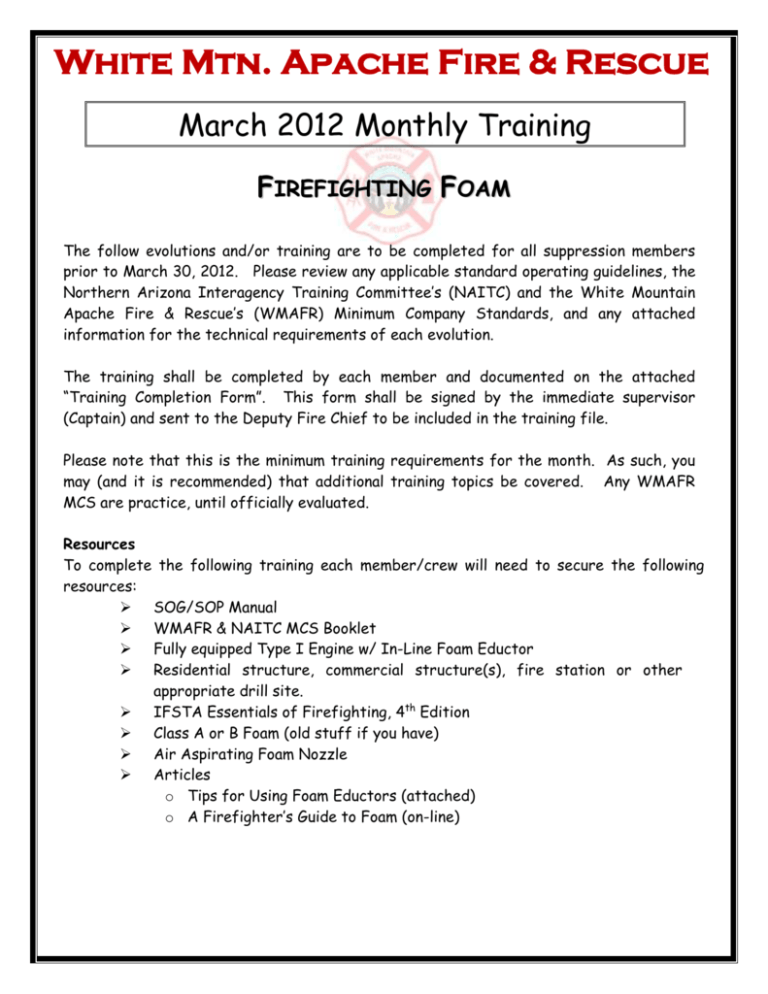
White Mtn. Apache Fire & Rescue March 2012 Monthly Training FIREFIGHTING FOAM The follow evolutions and/or training are to be completed for all suppression members prior to March 30, 2012. Please review any applicable standard operating guidelines, the Northern Arizona Interagency Training Committee’s (NAITC) and the White Mountain Apache Fire & Rescue’s (WMAFR) Minimum Company Standards, and any attached information for the technical requirements of each evolution. The training shall be completed by each member and documented on the attached “Training Completion Form”. This form shall be signed by the immediate supervisor (Captain) and sent to the Deputy Fire Chief to be included in the training file. Please note that this is the minimum training requirements for the month. As such, you may (and it is recommended) that additional training topics be covered. Any WMAFR MCS are practice, until officially evaluated. Resources To complete the following training each member/crew will need to secure the following resources: SOG/SOP Manual WMAFR & NAITC MCS Booklet Fully equipped Type I Engine w/ In-Line Foam Eductor Residential structure, commercial structure(s), fire station or other appropriate drill site. IFSTA Essentials of Firefighting, 4th Edition Class A or B Foam (old stuff if you have) Air Aspirating Foam Nozzle Articles o Tips for Using Foam Eductors (attached) o A Firefighter’s Guide to Foam (on-line) Training Goal For this month’s training, you will focus on foam for firefighting use using the in-line foam eductor. The in-line foam eductor is a lost tool (lost in the compartment and never trained on) and firefighters need to refresh on the use of it, as well as foam types available to them, percentages to use foam and methods to apply it. Training Objectives 1. Foam Review – Identify the various types of foam, the characteristics of each and their uses, the equipment required to apply them and application techniques. (2-3 Hours) a. How Foam Works/Generated i. How Foam Extinguishes ii. Foam Tetrahedron b. Expansion Rates i. Low Expansion ii. Medium Expansion iii. High Expansion c. Types of Foam i. Class A Foam ii. Class B Foam 1. Protein Foam 4. AR-AFFF 2. AFFF 5. AR-FFFP 3. FFFP iii. Polar Solvents vs. Hyrdocarbons d. Foam Percentages i. Class A – 0.1 to 1.0% ii. Class B – 1 to 6% e. How Foam is Injected i. Portable Foam Proportioners (what we are covering) ii. Apparatus-mounted Proportioners 1. Around the pump proportioners 2. Balanced pressure proportioners 3. Installed in-line eductors iii. Compressed Air Foam Systems f. How to Apply Foam i. Techniques 1. Roll-On Method 2. Bank-Down Method 3. Rain Down Method 2. In-Line Foam Eductor – The in-line foam eductor is the simplest foam proportioning system used in the fire service. It can flow all foam types and because of this its versatility, compared to integrated systems, is unmatched. Utilizing your Firefighter Skill Evaluation sheet, have each member assembly the in-line foam eductor so that the eductor is set to the proper nozzle and foam concentrate, as well as pumped at the proper pressures. In addition, ensure the firefighter: (2 Hours) a. Understands how back-pressure affects the Venturi affect. b. Understands the importance of flushing the in-line eductor and how to do it. c. How to improve the quality of finished foam through the use of nozzle attachments (e.g. air aspirating nozzles). d. Understands the most common reasons for failure to generate foam (IFSTA Essential Pg. 746). 3. Applying Firefighting Foam - It is important to use the correct techniques when applying foam from hand lines. If incorrect techniques are used, such as plunging the foam into a liquid fuel, the effectiveness of the foam is reduced. Utilizing your Firefighter Skill Evaluation sheet, have each member practice applying actual finished foam, given a scenario, using the three (3) techniques: (1 Hour) a. Roll-On Method b. Bank-Down Method c. Rain-Down Method 4. Minimum Company Standards – Review and re-practice the following MCS evolutions, incorporating the above training objectives. Be sure to use the In-Line Foam Eductor. (1 hour each). 1 3/4" Pre-Connect Foam Attack 5. MCS Testing – Utilizing the MCS Individual Competencies Evaluation Form have your deputy fire chief evaluate your crew on the 1 3/4" Pre-Connect Foam Attack. And one (1) additional minute to the evolution to compensate for the assembly of the in-line eductor. Retain a copy of the MCS for your record. 6. Firefighter Skill Evaluation (#2) – Utilizing the attached AzCFSE skill sheets, all members shall be evaluated on the following skills. Note: All members may and should be allowed to practice, but not before the evaluation. #142 – Assembling and Operating a Foam Fire Stream #141 – Correct Foam Selection WMAF&R Monthly Training Completion Form By signing below I am stating that each member listed has completed the objectives listed in the March 2012 WMAFR Monthly Training Packet (F FIREFIGHTING FOAM). I am also stating that each member is proficient at the individual skills and their appropriate application. The following evolutions have been completed: □ □ □ □ □ □ Foam Review Inline Foam Eductor Applying Firefighting Foam MCS Practice: 1 3/4" Pre-connect Foam Attack MCS Testing: 1 3/4" Pre-connect Foam Attack (+1 minute addition) Firefighter Skill Evaluations: Assembling and Operating a Foam Fire Stream and Correct Foam Selection Each member is responsible for the information provided in this training packet. Members will be individually evaluated on the skills included in this packet during the quarterly evaluation/training session(s). Officer’s Printed Name Date Officer’s Signature Date Members in attendance Name Foam Review In-Line Foam Eductor Applying FireFighting Foam MCS MCS Testing Forward completed form to the Deputy Fire Chief for retention in the training file. FF Skill Eval. #3 Tips for Using Foam Eductors By Keith Klassen When asked if our apparatus has foam capability, most fire departments will respond in the affirmative. For many departments, saying “yes” means that they have a foam eductor. Eductors may be portable or plumbed into the apparatus. If they’re portable, they’re usually relegated to the back of the engineer’s cabinet where they’re covered in a layer of dust. If they’re plumbed, they’re often plugged with dried foam concentrate. Both situations are a good indication of how infrequently we use them. This lack of use is often due in large part to a lack of training and practice with the system. This month, we’ll shed some light on the mysteries of eductors. How It Works Foam eductors operate using the Venturi Principal. The eductor’s inlet has a large diameter as compared to the small diameter in the center or Venturi area of the unit. The outlet of the eductor returns to the original inlet diameter. The result is that all the water entering the eductor is forced through the small center opening. In order for this to occur, the velocity of the water must increase in small diameter. The increase in velocity reduces pressure in the Venturi area, which allows the foam concentrate to enter the water stream as atmospheric pressure pushes on the concentrate in the foam bucket or tank. This is the same principal by which carburetors provide fuel to engines and airplane wings create lift. Eductor Placement Eductors come in various sizes, ranging typically from 60 gpm to 250 gpm, and can be attached directly to the apparatus discharge. They may also be placed between two hose sections in the discharge line. Moving the eductor down the hoseline may be required if a long line is being pumped, as there are restrictions on how much hose can extend past the eductor. These restrictions range from 150 to 300 feet depending on the eductor. The eductor may also need to be moved away from the discharge if the discharge plumbing is creating turbulence entering the eductor. Such turbulence can disrupt the operation of the Venturi. Pump Pressures & Percentages Eductors are typically pumped with a 200-psi inlet pressure. This is due to the high friction loss, roughly 30 percent, through the small Venturi area. The pick-up tube can be placed in a foam bucket or attached to a foam tank supply. For Class B operations, a large supply of concentrate will be needed due to the high percentages required. The percentage can be adjusted to 0.5, 1.0, 3.0 or 6.0 percent; some models have a 0.25 percent setting. Each setting is simply a specific orifice size that allows the correct amount of concentrate to enter the water stream. During & After the Operation Flows during the operation must remain constant at the rated gallons per minute. This fact makes the use of an eductor problematic for Class A foam firefighting where lines are constantly being opened and closed. Eductors work much better in Class B operations where foam is being flowed constantly on a fire or a spill for a longer period of time. When the operation is complete, the eductor must be flushed. This is best done by removing the pick-up tube from the concentrate source and placing it in a bucket of water. The hoseline can then be flowed until clear water is exiting the nozzle. Important: Do not leave foam concentrate in the eductor as it will dry, attract dirt and plug the small orifices. It may also cause the internal check ball to stick. If the check ball is stuck open, this could result in water flowing back into the concentrate supply. If the check ball is stuck shut, it could result in no foam entering the eductor. Things to Remember When using foam eductors, remember that they’re situation-sensitive. They must be operated in precisely the correct parameters to operate effectively. For example, the flow through the eductor must match its rating. Drastic variations and/or incorrect flow will affect the pressure drop through the Venturi and, therefore, prevent its operation. The eductor must also be matched to the correctly adjusted nozzle, which must discharge at a constant rate. There are several other factors that will disrupt the eductor’s operation. These factors have one thing in common: They all create 5 psi or greater of back pressure downstream of the eductor. One factor, elevating the nozzle more than 10 feet, creates head pressure. Another factor, excessive hose beyond the educator, increases friction loss. Other factors, such as an incorrect or partially opened nozzle and kinks in the hoseline, restrict flow, creating back pressure. Final Thoughts Eductors can be great tools, but they must be set up and operated properly to be effective. As with everything that we do in the fire service, training is the key. Regular practice with your equipment will ensure that the steps for proper operation are second nature when the call comes in at 0 dark 30. A firefighter operates a foam eductor. Remember: Eductors can be great tools, but they must be set up and operated properly to be effective. Photo Keith Klassen A selectable gallonage nozzle must be adjusted to match the eductor flow rating.

